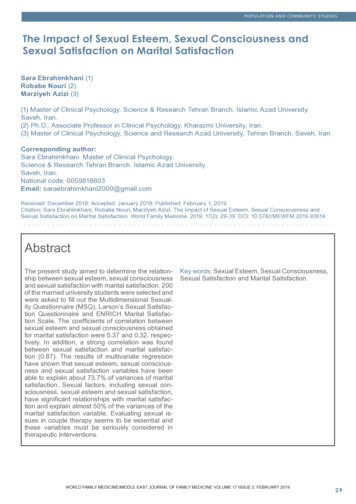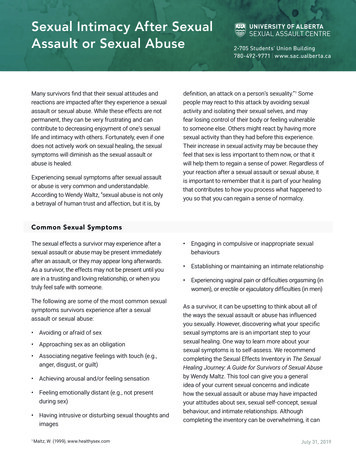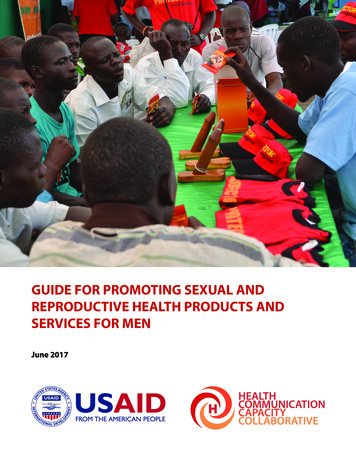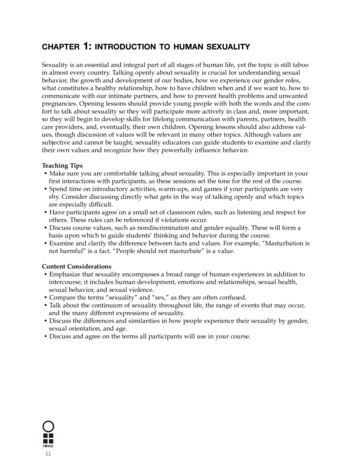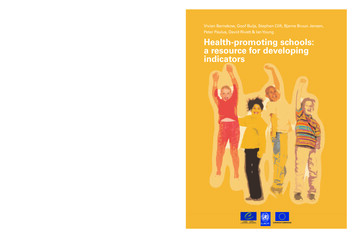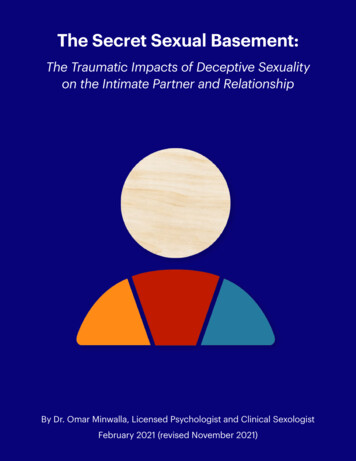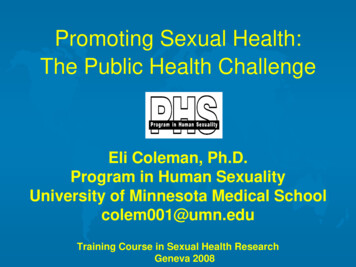
Transcription
Promoting Sexual Health:The Public Health ChallengeEli Coleman, Ph.D.Program in Human SexualityUniversity of Minnesota Medical Schoolcolem001@umn.eduTraining Course in Sexual Health ResearchGeneva 2008
Meeting the Challenge:A Public Health Imperative 42 million living with HIV/AIDS340 million new cases of STI’s per yearMajor cause of infertility is STI/RTI infection15 million women under 20 give birth per year; many unintended.Unsafe abortion leads to a myriad of health consequences8-33% of the adult population with some kind of sexual dysfunction20-50% of women have suffered physical violence from partners.12 and 25% of women have experienced forced sex during their lives.Untold numbers of violence against sexual minoritiesChild sexual abuse affects 10-25% of women; 3-13% of men.
What is common to thesedifferent domains? Sexualbehavior Context of sexual relationship Interrelationship of physical, mental, sexualand reproductive health
Structural Factors Poverty Racism Aculture uncomfortable talking about sexexcept in joking – especially abouthomosexuality Lack of sexuality education Heterosexism and Homophobia
Failureto recognize that most infections occurbetween men who have sex with men – and lackof political resolve to care for those at risk. Institutionalized discrimination – creating fear of“coming out.” Religious perspective: Sex for procreation, not forpleasure or health Catholic church’s stand on barrier contraceptionhas not been modified by disease prevention needs Moralism rather than scientific informationdictating public policy
Discrimination and Oppression
Lackof citizenship for all human beings
Citizenship Citizenshipconfers upon us those rights andresponsibilities that come with equalmembership and participation in acommunity. Such membership is not onlyframed in relationship to the legal rulesestablished by the state, but also throughsocial relationships between individuals(Lister, 1997)
Sexual Citizenship Thisframing makes a whole lot of peoplewith non-conforming sexualities, differentgenders (beyond the binary), sex workers,people living with HIV/AIDS, etc. –full citizens with full claims to resources,recognition and to representation.
Discrimination and Oppression
Society’s Failure Failure to recognize that the most vulnerable aredisproportionally denied sexual health – and lack ofpolitical resolve to care for those at risk.Institutionalized discriminationReligious perspective: Sex for procreation, not for pleasureor healthReligion’s stands on contraception, abortion,homosexuality, sex outside of marriage has not beenmodified by disease prevention or sexual health promotionneedsMoralism rather than scientific information dictatingpublic policy
Barrier to Sexual HealthLack of citizenshipfor all human beings
Lack of citizenshipfor all human beings
Citizenship Citizenshipconfers upon us those rights andresponsibilities that come with equalmembership and participation in acommunity. Such membership is not onlyframed in relationship to the legal rulesestablished by the state, but also throughsocial relationships between individuals(Lister, 1997)
Sexual Citizenship Thisframing makes a whole lot of peoplewith non-conforming sexualities, differentgenders (beyond the binary), sex workers,people living with HIV/AIDS, etc. –full citizens with full claims to resources,recognition and to representation.
Addressing the “Syndemic”Responding with a SystematicApproach
Sexual Health as theOverarching Framework ofHIV Prevention/ReproductiveHealth Promotion
SexualHealthModel
Components of SexualHealth 1.Ability to talk about sex and sexuality. 2. Culture and sexual identity. 3. Sexual anatomy and functioning. 4. Sexual health care and safer sex. 5. Awareness of sexual health barriers. 6. Self-acceptance (body and genital image). 7. Masturbation and fantasy. 8. Positive sexuality. 9. Intimacy and relationships. 10. Spirituality and Integration
Robinson, B.E., Bockting, W.O.,Rosser, B.R.S., Rugg, D., Miner,M. & Coleman, E. (2002). TheSexual Health Model: Applicationof a sexological approach to HIVprevention. Health EducationResearch: Theory & Practice,17(1), 43-57.
Time to Develop Global,Regional and National PublicPolicies to PromoteSexual Health
A Public Health Imperative!!!
Developing Public PoliciesPromote Sexual Health In 1975, the World Health Organization(WHO) produced a historic document. It called upon societies to provide thenecessary sexuality education,counseling, and therapy to promotesexual health and to provide necessarytraining for health professionals. This document also served as a stimulusfor the development of the field ofsexology and sexual resources centersthroughout the world. It contained a basic definition of sexualhealth.http://www2.hu-berlin.de/sexology
Developing Regional StrategiesPan American Health Organization New definitions of sex, sexuality andsexual health and promoting the followingregional goals and strategies: Promote sexual health;Provide comprehensive sexualityeducation;Provide education, training, and supportto professionals;Develop and provide access tocomprehensive sexual health care services;Promote and sponsor research. Health.pdfhttp//www.paho.org/Spanish/HCP/HCA/salud sexual.pdf
National Strategies TheNational Indigenous Australians’Sexual Health Strategy 1996-97 to 19981999 (Australia) Australia’s Health 2000, Australian Instituteof Health and Welfare National Strategy for Sexual Health andHIV, Department of Health - UnitedKingdom
June 28, lth/
Developing National Strategies toPromote Sexual Health Inthe case of Australia andthe United Kingdom, thestrategies to promote sexualhealth were more specificallytied to HIV prevention. However,most recently, abroader strategy to promotesexual health and responsiblesexual behavior was unveiledin the United l health
Serious disparities in thepopulations affected:AdolescentsEconomically DisadvantagedPeople of ColorSexual Minorities
Developing Global Strategies:World Health Organization WHO held an internationalconsultation to discussapproaches and strategies forpromoting sexual health: To elaborate new workingdefinitions of sex, sexuality,sexual health and sexualrights; To serve as a basis forcountries to develop their ownstrategiesGeneva, January 28-31,2002
New working definitions of sex,sexuality, sexual health and sexualrights al health.html
Sex Sexrefers to the biological characteristics whichdefine humans as female or male.[These sets of biological characteristics are notmutually exclusive as there are individuals whopossess both, but these characteristics tend todifferentiate humans as males and females. Ingeneral use in many languages, the term sex isoften used to mean "sexual activity", but fortechnical purposes in the context of sexuality andsexual health discussions, the above definition ispreferred.]
Sexuality Sexualityis a central aspect of being humanthroughout life and encompasses sex, genderidentities and roles, sexual orientation, eroticism,pleasure, intimacy and reproduction. Sexuality isexperienced and expressed in thoughts, fantasies,desires, beliefs, attitudes, values, behaviours,practices, roles and relationships. While sexualitycan include all of these dimensions, not all of themare always experienced or expressed. Sexuality isinfluenced by the interaction of biological,psychological, social, economic, political, cultural,ethical, legal, historical and religious and spiritualfactors.
Sexual Health Sexualhealth is a state of physical, emotional,mental and social well-being related to sexuality;it is not merely the absence of disease, dysfunctionor infirmity. Sexual health requires a positive andrespectful approach to sexuality and sexualrelationships, as well as the possibility of havingpleasurable and safe sexual experiences, free ofcoercion, discrimination and violence. For sexualhealth to be attained and maintained, the sexualrights of all persons must be respected, protectedand fulfilled.
Sexual Rights Sexualrights embrace human rights that arealready recognized in national laws,international human rights documents andother consensus documents. These includethe right of all persons, free of coercion,discrimination and violence, to:
Sexual Rightsthe highest attainable standard of health in relation tosexuality, including access to sexual and reproductivehealth care services; seek, receive and impart information in relation tosexuality; sexuality education; respect for bodily integrity; choice of partner; decide to be sexually active or not; consensual sexual relations; consensual marriage; decide whether or not, and when to have children; and pursue a satisfying, safe and pleasurable sexual life.The responsible exercise of human rights requires that allpersons respect the rights of others.
Probably the most controversialissue that has daunted manyconstructions of sexual health isthe issues of pleasure and sexualrights.
The responsibility of the state hasbeen made clear: to respondstrategically andcomprehensively to the plethoraof sexual health problems as anessential means of promotinghuman development.
Lessons Learned Groupsfrom diverse backgrounds were able to findcommon ground on evidenced-based strategies topromote sexual health. There is remarkable consistency throughout thesedocuments. They have all contributed to a clarity inour definitions of sex, sexuality, and sexual health. It has taken collaboration from leaders in HIV/AIDSand sexual, reproductive, child and adolescent, andmental health to produce comprehensive sexualhealth goals and strategies.
Lessons Learned Collaborationfrom leaders from diversebackgrounds in the health sector were needed toproduce comprehensive sexual health goals andstrategies. They were able to find common groundon evidenced-based strategies.
Conclusion Oneof the most exciting andpotentially significant advancesin HIV/AIDS policy worldwidehas been the development ofdocuments at the national,regional and international levelsadvancing sexual health.
Sexual Health for the MillenniumA Declaration and Technical Document
The Sexual Health for the MillenniumDeclarationThe promotion of sexual health is central to theattainment of wellness and well-being and theachievement of sustainable development and morespecifically to the implementation of the MillenniumDevelopment Goals. Individuals and communitieswho experience well-being are better positioned tocontribute to the eradication of individual andsocietal poverty. By nurturing individual and socialresponsibility and equitable social interactions,promotion of sexual health fosters quality of life andthe realization of peace. Therefore we urge allgovernments, international agencies, private sector,academic institutions and society at large, andparticularly, all member organizations of the WorldAssociation for Sexual Health to:
Sexual Health for the Millennium 1. Recognize, promote, ensure and protect sexual rights for allSexual rights are an integral component of basic human rights and thereforeare inalienable and universal. Sexual health is an integral component of theright to the enjoyment of the highest attainable standard of health. Sexualhealth cannot be obtained or maintained without sexual rights for all.2. Advance toward gender equality and equitySexual health requires gender equality, equity and respect. Gender-relatedinequities and imbalances of power deter constructive and harmonic humaninteractions and therefore the attainment of sexual health.3. Condemn, combat, and reduce all forms of sexuality related violenceSexual health cannot be attained until people are free of stigma,discrimination, sexual abuse, coercion and violence.4. Provide universal access to comprehensive sexuality education andinformationTo achieve sexual health, all individuals, including youth, must have access tocomprehensive sexuality education and sexual health information and servicesthroughout the life cycle.
Sexual Health for the Millennium5. Ensure that reproductive health programs recognize the centrality of sexualhealthReproduction is one of the critical dimensions of human sexuality and maycontribute to strengthening relationships and personal fulfillment when desired andplanned. Sexual health encompasses reproductive health. Current reproductivehealth programs must be broadened to address the various dimensions of sexualityand sexual health in a comprehensive manner.6. Halt and reverse the spread of HIV/AIDS and other sexually transmittedinfections (STI)Universal access to effective prevention, voluntary counseling and testing,comprehensive care and treatment of HIV/AIDS and other STI are equally essentialto sexual health. Programs that assure universal access must be scaled upimmediately.7. Identify, address and treat sexual concerns, dysfunctions and disordersSince sexual concerns, dysfunctions and disorders impact quality of life, it iscritical to recognize, prevent and treat sexual concerns, dysfunctions and disorders.8. Achieve recognition of sexual pleasure as a component of holistic health andwell-beingSexual health is more than the absence of disease. The right to sexual pleasureshould be universally recognized and promoted.
Sexual Health for the Millennium Itis essential that international, regional,national and local plans of action forsustainable development prioritize sexualhealth interventions, allocate sufficientresources, address systemic, structuraland community barriers and monitorprogress
Before we begin Isthe definition operationalizable? Whatis the meaning of the specificwording? Isthe definition complete?
Of Measurement & Meaning Howdo we define &measure:If we must wait for thesexual rights of all– Physical well-being,persons to be respected,– Emotional well-being,protected and fulfilled – Mental well-being– Social well-being?It may be a long timebefore we realize sexual We have measures ofhealth in any society.– Sexual disease,– Sexual dysfunction– Sexual infirmity (dowe?)
Leadership needed from theHealth Sector Leadershipis needed in the health sector to:– create better climates for discussion of sexuality– access to information and education about sexuality– prevention strategies to include community-basedinterventions– access to care for sexually related concerns,– more research in human sexuality and evaluation ofprograms designed to promote sexual health andresponsible sexual behavior.
A Public Health Approach isNeeded While it is too early to assessthe impact of such documentson national, regional orinternational policy, it isimperative that policies basedupon a public health approachbe developed and implemented.
Besides more research, moremoney for prevention, we needleadership, vision, courage,commitment to strategize for thepromotion of a sexually healthiersociety.
We have a public healthimperative.Doing nothing is unacceptable.
We can create a sexuallyhealthy world in the thismillenium!!!
Meeting the Challenge: A Public Health Imperative 42 million living with HIV/AIDS 340 million new cases of STI's per year Major cause of infertility is STI/RTI infection 15 million women under 20 give birth per year; many unintended. Unsafe abortion leads to a myriad of health consequences 8-33% of the adult population with some kind of sexual dysfunction

